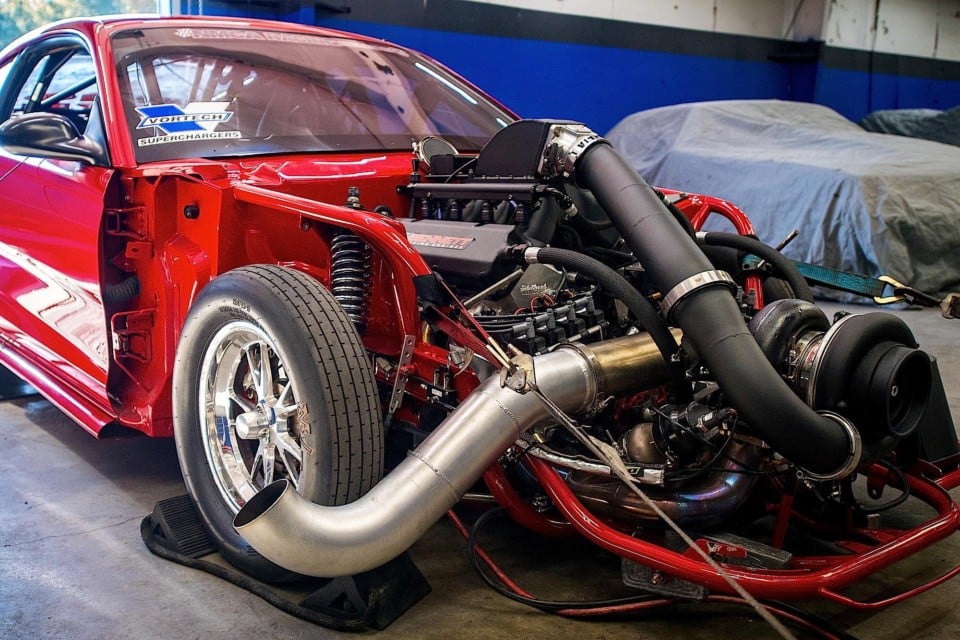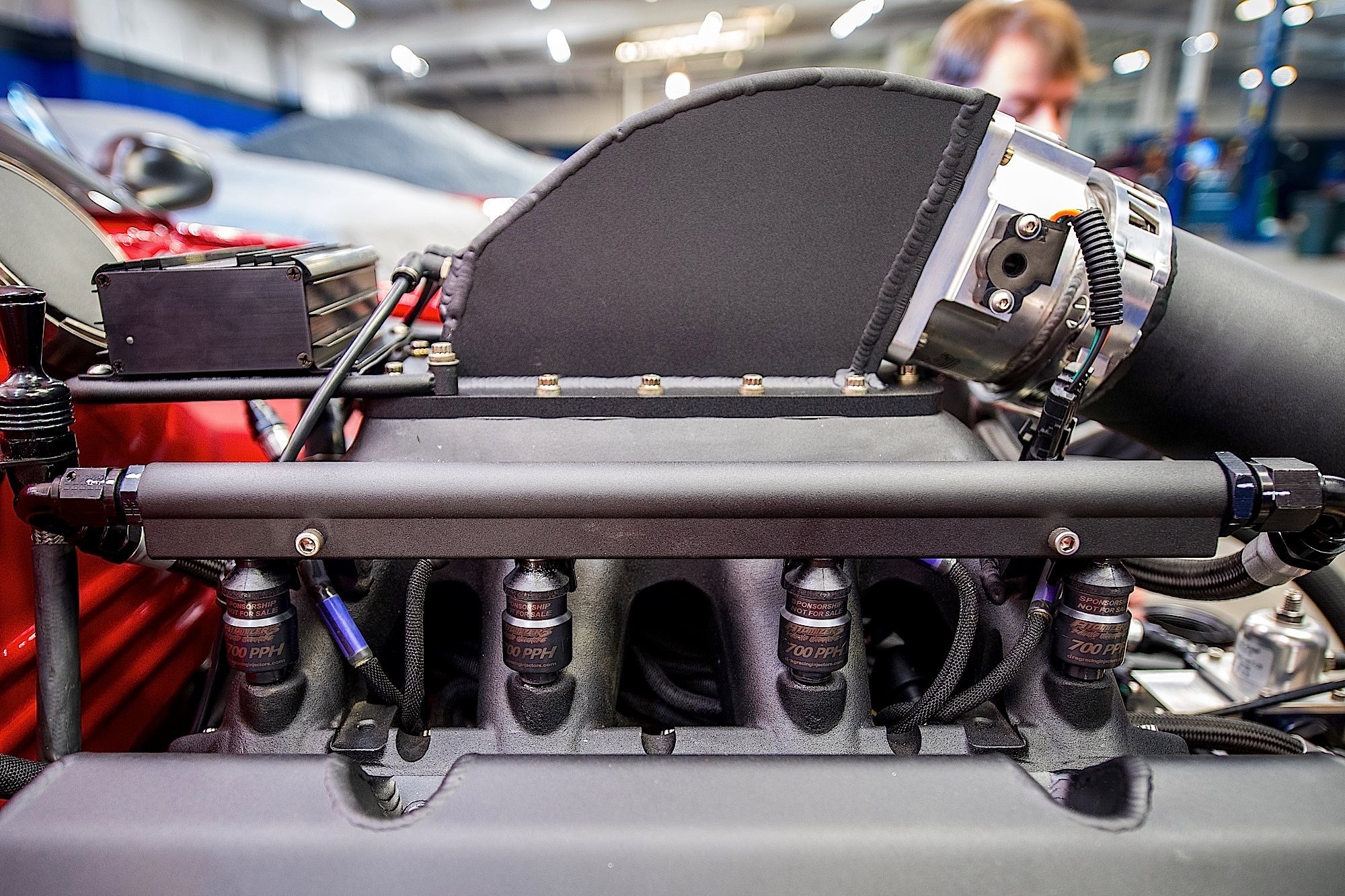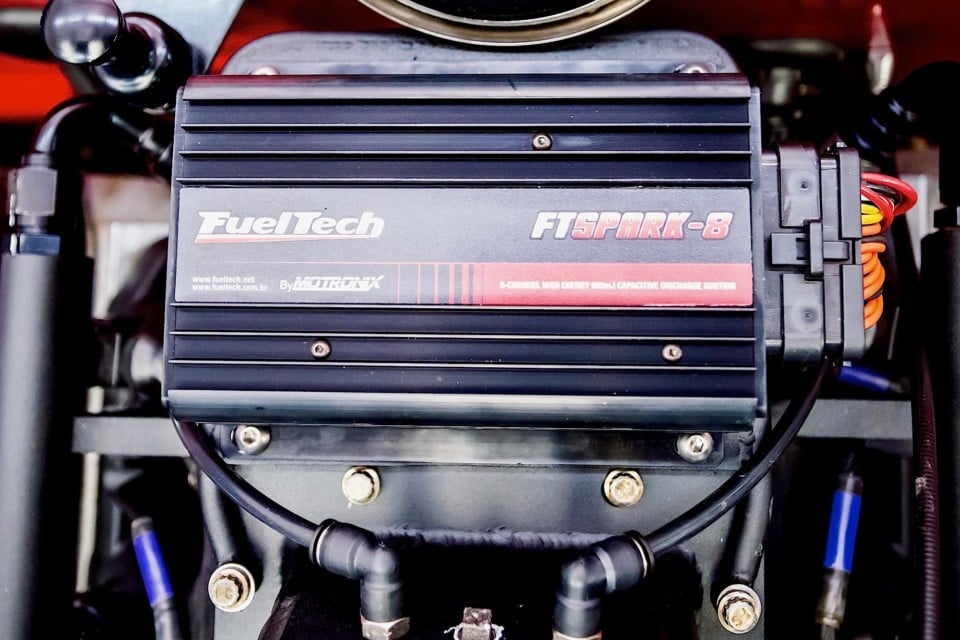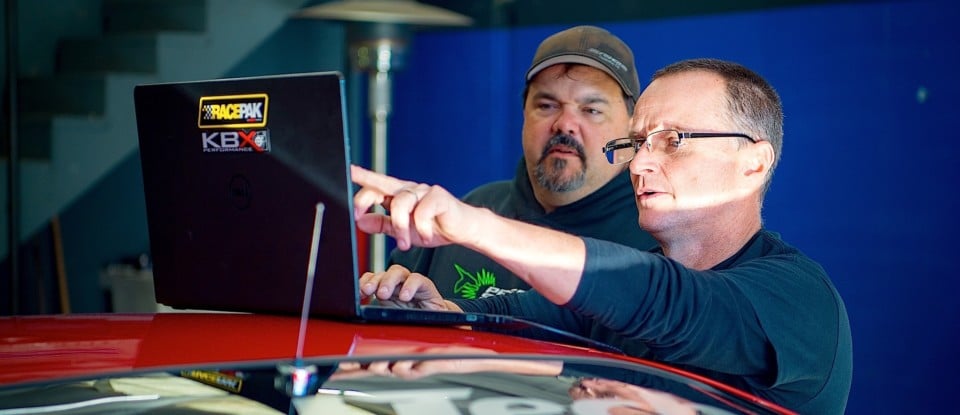Taking a gasoline-fed drag car and setting it up to run on methanol not only improves power but may also help the car shed a few pounds. That was the direction taken by engine tuner John Kolivas as he converted a turbocharged ’96 Mustang into a grudge racer that isn’t required by rules to meet a minimum weight.
“In order to get as much weight out of the car as possible, we swapped it over to [VP Racing] M1 fuel,” says Kolivas, adding that the improved engine performance also helped the car lower its personal-best e.t. after only a few shakedown passes. “It’s gone quicker than ever before in just a handful of runs. It definitely looks promising and just needs more laps.”
Both fuel and ignition issues had to be addressed to make the conversion successful. Since methanol has less energy content than gasoline, more fuel must be fed to the engine. Methanol’s flame-burning properties also meant that a more powerful spark was needed. The car already had a FuelTech FT600 ECU, so the fuel issue was solved with larger injectors and recalibrating the fuel maps. The ignition needed more attention, however, because traditional solutions for methanol usually involve swapping on a magneto. The team wanted more tuning flexibility, though, so a programmable FuelTech FTSPARK-8 capacitive discharge ignition box along with a coil-per-plug arrangement was installed and connected to the FT600.
“Until now, a magneto was the only available ignition system capable of supplying that kind of energy,” says Anderson Dick of FuelTech. “It makes a lot of energy, but more people are using timing retard instead of ignition cut to do any kind of power management. If you’re running a mag, you’re not able to pull the timing.”
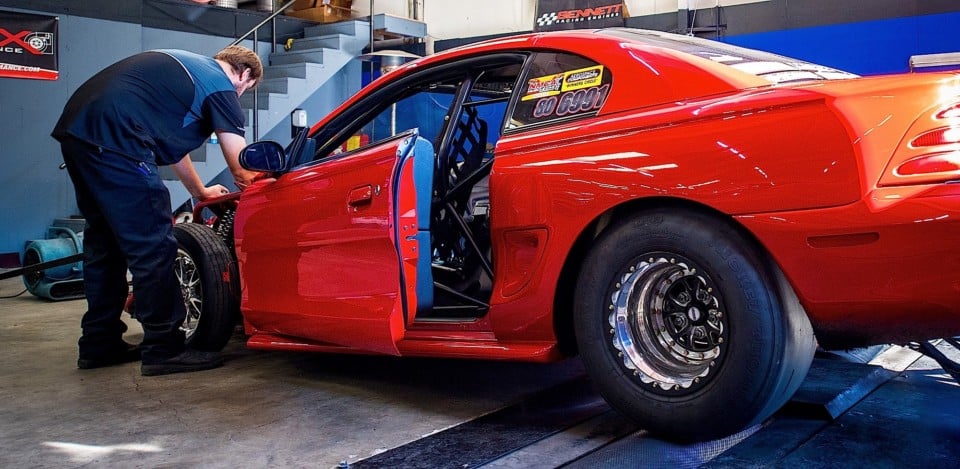
Chassis dyno runs revealed a conservative 2,000 horsepower to the tires with the methanol conversion.
Daniel Pharris campaigned the Mustang in 2018, setting a turbo record in the NMCA Street Outlaw division and winning one race after reaching the finals three times in six outings. Kolivas, who originally built the car along with engine builder Jon Bennett out of their KBX Performance shop, then brokered a deal to sell the Mustang to James Lawrence, who wanted a turbo car for no-time outlaw-style competition.
The car is powered by a 430ci small-block Ford and backed by a two-speed transmission with a 1.58:1 First gear. The engine is based on a Bennett/Dart billet aluminum block with a 10.000-inch deck height and a raised-cam location that supports 60mm roller bearings. The block is also machined with .937-inch keyway lifter bores with revised angles to correct the geometry with the raised-cam location.
Engine internals include a Callies billet 4.000-inch-stroke crankshaft, GRP connecting rods, Diamond pistons, Total Seal rings and Calico coated bearings. A Danny Bee belt drive turns the Bennett tool-steel camshaft that sets the Jesel lifters in action.
Edelbrock SC1 cylinder heads are CNC machined to Bennett’s specs and fitted with Victory valves, PSI springs and Jesel steel rocker arms. A CID intake manifold is ported to match the cylinder heads, then machined and fitted with custom hat and massive Wilson 125 mm throttle body.
“We did not run a dry sump due to the car already set up for a specific oil pan and single-stage external oil pump,” says Bennett. “We modified the existing pan to fit our billet block. Alcohol would have no effect on the oiling setup, meaning we would not treat either system any different on alcohol.”
The team retained the Gen II Precision 98mm turbocharger and FuelTech FT600 fuel-injection system, the latter of which had to be made to support the additional fuel that had to be pumped and delivered to the cylinders. First chore, however, was removing the intercooler, water tank and associated plumbing from the system, that would not be as useful with methanol.
“There’s now a new charge pipe from the turbo to the intake. Overall we took about 100 pounds out of the car,” says Kolivas. “Going to M1 will pretty much require double the fuel consumption.”
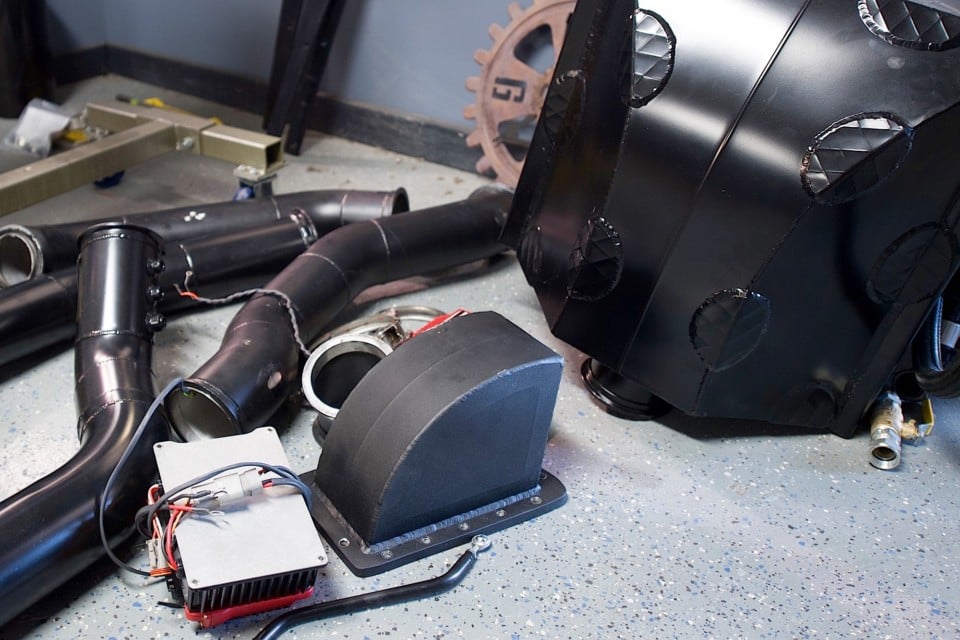
Here are the vehicle components removed during the conversion to methanol. A new hat for the intake manifold had to be fabricated because the original one shown in the photo interfered with the hood when turned around to face forward. The original spark box was also removed as the conversion includes a new spark-control system that doesn’t require a distributor.
What is methanol?
Methanol is an oxygen-bearing fuel that today is normally synthesized from natural gas. In its early days, methanol was produced from wood and widely used as a cooking fuel in Europe. In the early 20th century, a French chemist discovered that methanol could be manufactured using carbon monoxide and hydrogen. Since it previously took one ton of wood to produce six gallons of methanol, the new synthetic method became the preferred manufacturing process, although it has been refined with new feedstock materials — including coal and natural gas — over the past 120 years.
Methanol has a number of positive combustion characteristics that serve the racing engine. A given amount of air can burn much more methanol at stoichiometric mixtures than gasoline, and maximum power on methanol is usually achieved at mixtures very rich of stoichiometric. Methanol also resists knock, so higher compression ratios and higher boost levels are generally achievable. The fuel’s high heat of vaporization will chill the air enough to improve volumetric efficiency. In other words, methanol engines run quite cool at maximum power, and typically don’t require an intercooler in boosted applications.
In the mid-’60s methanol became the preferred fuel for USAC events, including the Indy 500 where two drivers in 1964 died in gasoline-fed car fires. Unlike gasoline, a methanol fire can be extinguished with just water. Also, a methanol fire doesn’t produce a visible flame or smoke, so oncoming drivers have a cleaner field of vision when approaching an accident.
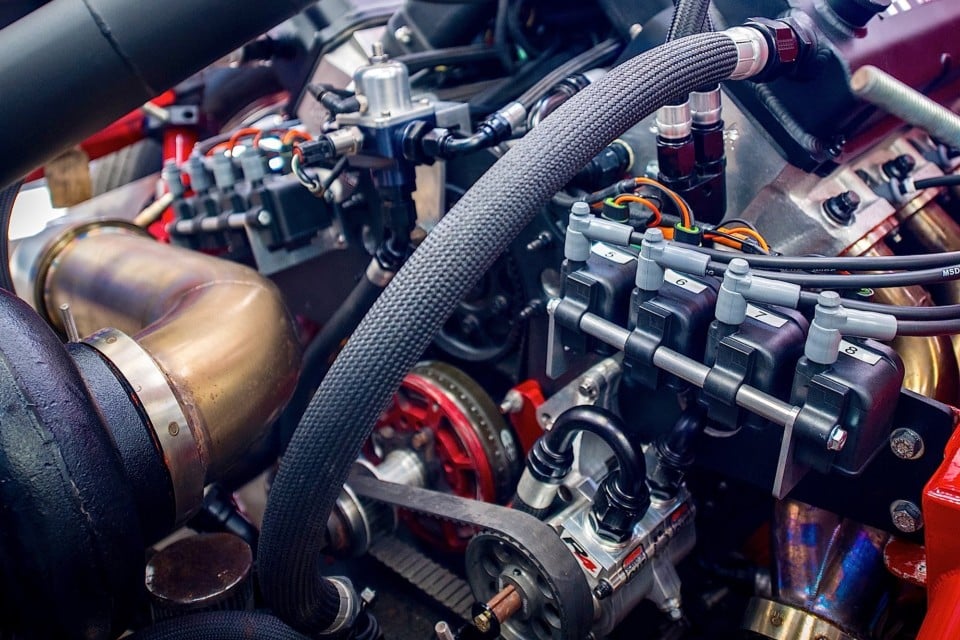
Note the external wet-sump oil pump that is driven half crank speed with a belt drive. The Waterman fuel pump is mounted behind the oil pump. Also shown are the individual coils and the crank trigger on the damper for the ignition system.
Methanol carries a relatively low energy content, and therefore the engine requires increased fuel supply. In fact, in certain situations, the sheer volume of fuel injected into the engine can have an effect on cylinder pressure to the point of requiring a reduction in the engine’s static compression ratio to compensate. However, that wasn’t the case in this instance.
Kolivas swapped out the 225-pound-per-hour fuel injectors for a set of Billet Atomizer 700-pound-per-hour units. These injectors are hand-built, blueprinted and flow-tested before delivery. They’re designed to deliver a consistent pulse-to-pulse dosage and spray a smaller droplet size.
“I think those injectors are in the mid-80s [percent] for duty cycle right now, but the turbo is putting all the boost out that it’s going to put out. So we’re fine as far as injectors,” says Kolivas. “If there’s ever a bigger turbo, like a 106mm or 108mm, we may need to step up to an 800-pound injector.”
More fuel, more fuel!
Kolivas knew from the start of the conversion that the 6 gpm pump would struggle to meet the fuel delivery demand of the larger injectors. He had to step up the volume and install a Waterman Racing Nostalgia Lil Bertha pump, which is driven off the rear of the Peterson oil pump and is set up to flow 16.5 gpm. The system now provides 90 psi baseline with up to 125 psi available at the end of the run.
The Waterman Nostalgia Lil Bertha pump doesn’t really live up to its name as “little” except in its physical size. Originally designed to bring the standard Lil Bertha pump into compliance with the Nostalgia racing rules there are a couple key differences between the standard Lil Bertha, and the Nostalgia variant. “The Nostalgia Lil Bertha was developed for the NHRA Hot Rod Heritage series,” explains Shawn Dill, Manager of Waterman Racing. “The standard Lil Bertha pump has a gear cavity that is 1.7 inches wide. NHRA limited that size so we built the Lil Bertha Nostalgia which is only 1.2 inches wide.”
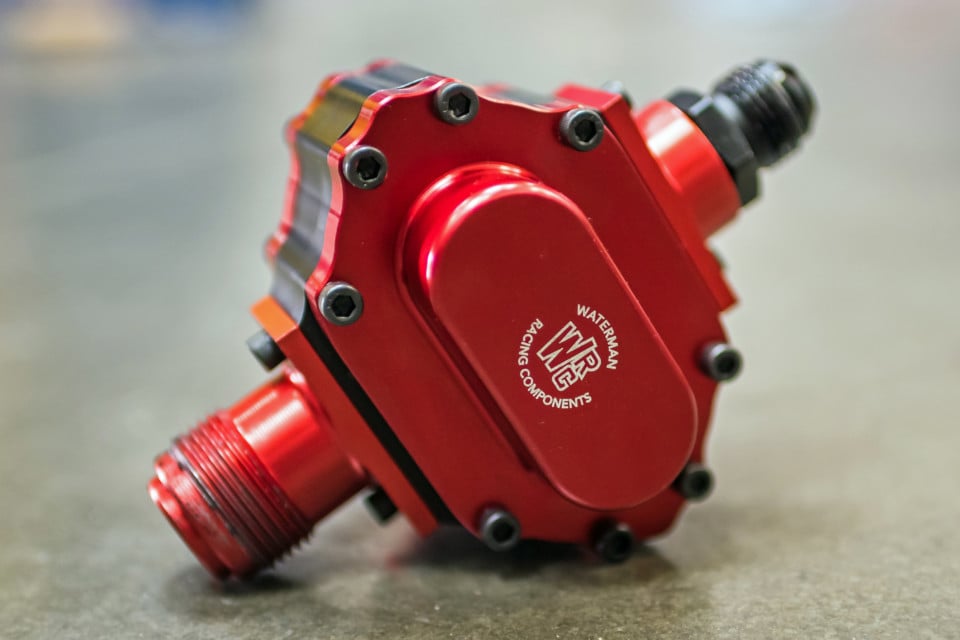
Here’s a closer look at the Waterman Racing Nostalgia Lil’ Bertha fuel pump. Originally designed to meet the restrictive NHRA Hot Rod Heritage series rules, doorslammers running complex underhood power-adder systems quickly learned to appreciate the unit’s compact size and immense flow capabilities.
That size difference may not seem like a lot, but the Nostalgia Lil Bertha’s compact dimensions haven’t escaped the notice of door-car racers. “When you have a complex turbo or centrifugal supercharger combination — with all kinds of plumbing in the engine bay — that half an inch in height and width becomes pretty important, packaging-wise,” Dill relates.
With its interchangeable gearsets, the Lil Bertha’s output range can be tailored up to 23 gpm of nominal fuel flow at the high end. “We try to match the pump to about 20-30-percent over the injectors’ maximum flow,” explains Dill. “If you have a big high-flow pump and are only using a small fraction of that flow, all that fuel is being returned back to the tank from the regulator. If the tank isn’t perfectly designed as far as baffling or how the returns are directed into the fluid, you can have all kinds of agitation and aeration going on in the tank, then when you put your foot to the floor, your tank is a foamy, frothy mess, and you get a lean condition.”
In addition to a versatile output range, the Lil Bertha mounts three separate ways — a reverse-rotation swivel, standard-rotation V-band, or a standard-rotation 4-bolt flange. In addition to the mounting options, it can be driven with a standard belt drive, or via a cable-driven belt-drive unit, further increasing mounting versatility. It is also available with a steel center section, which increases the unit’s corrosion resistance and deflection under extreme pressures — both key variables when you are talking about clearances measuring less than .001-inch.
“It already had a large enough fuel-line system, and the fuel tank was mounted in the front of the car,” says Kolivas.
When the intercooler and plumbing were in place, the induction hat, or sometimes called the elbow, was reversed to receive the cold-air charge from the water box that was mounted in the car’s interior. With the turbo now feeding directly into the intake manifold, a new hat had to be fabricated. The original hat could not be used because when turned around to face the front it interfered with hood clearance.
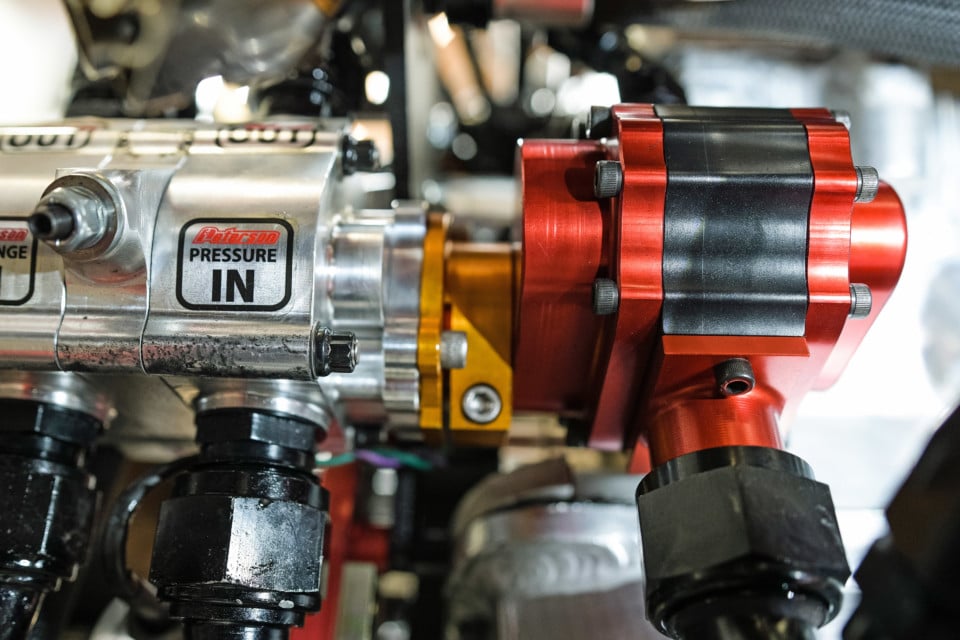
Driven off of the external oil pump system, the Nostalgia Lil’ Bertha offers changeable gearsets to tailor the fuel flow rate to exactly the needs of your application. The version we used is geared to provide 16.5 gpm of methanol, with a maximum capability of 23 gpm from the smaller Nostalgia version.
Lighting It All Off
Aside from swapping the fuel injectors and pump, the other critical conversion factor is ignition.
“Until recently, the only choice for running a high-horsepower alcohol setup was a magneto,” reminds Kolivas. “Running M1 obviously requires precise control over the ignition spark. We removed the distributor style setup and basic ignition box and installed the FuelTech FTSPARK-8. It allows you to tailor the spark output you need for the tune-up at whatever power level you’re running in the car. Our setup will be around 2,000 to 2,500 horsepower, which won’t push the FTSPARK-8 at all.”
The new ignition system removes the previous distributor and control box. A new FuelTech harness connects to eight individual coils.
“It’s a pretty simple swap,” adds Kolivas. “We only had to build a couple of mounts for the coils.”
One of the key innovations of the FTSPARK-8 that makes it ideal for methanol is the ability to adjust the energy level of the spark in addition to controlling the timing of the spark. According to the company, the spark is adjustable between 400 millijoules (mJ) of energy up to 600 mJ.
“The spark energy being programmable allows the tuner to actually use this as a tuning aspect. A higher energy spark eventually can burn leaner or richer mixtures and at the same time bring more heat to the plug,” says Anderson.
Certain types of rev limiters and two-steps may make it difficult for the engine to recover at the start, and this recovery period can be inconsistent from run to run–which is a disadvantage to accurate tuning. Yet, the start is also when the engine needs a hot spark.
“You need to recover immediately so you have total control of your engine,” says Anderson. “So whenever you want to cut the cylinder, the next cycle you want to have it back full power, you need a strong ignition to be able to do that.”
The new ignition system ties in neatly with the FuelTech FT600 ECU that controls both fuel delivery and spark timing. It offers a built-in touch-screen display that allows certain adjustments without the use of a laptop.
“It’s the brainbox of the entire FuelTech system,” says Kolivas. “It gives you the ability to change the tune on the fly, make adjustments in the staging lanes and the burnout box. It gives you five preset tuneups on the dashboard. You can reach in as late as right before staging and completely change the map, if you want to.”
Here are two close-up views of the massive new Billet Atomizer 700 lb/hr injectors and intake manifold hat.
Managing power during the run may require the tuner to pull back timing at certain points in the run. With the FTSPARK-8, the tuner can also pull back spark power.
“You launch with 600 because maybe that’s where you have a transbrake or some type of traction control,” explains Anderson. “Then you use the tuning aspect to make more horsepower. You phase the power back from 600 to 400 millijoules and these will actually show less heat on the plug—which will allow you to run a little less fuel and make a little more horsepower. And still be safe and not hurting the engine.”
The car is set up to run only eighth-mile events, so the fuel and timing maps are set up for that distance with a laptop. The differences between the maps are developed around varying track and performance scenarios.
“The FTSPARK-8 has 600 millijoules concentrated in 300 microseconds of discharge. That means that we have more than double the energy that a mag can do in the beginning of a spark,” says Anderson. “This is important because a magneto can actually even have 900 millijoules but this in very low duration. It’s not a concentrated spark. The FTSPARK-8 was designed for alcohol with a very concentrated spark at the beginning of the discharge. If you’re firing your engine at 20 degrees of timing, the FTSPARK-8 will probably be the best guarantee that your effective timing is 20 degrees.”
“Track conditions, different driveshaft curves, different engine-speed curves,” says Kolivas. “We also have different boost ramps for different engine curves and different driveshaft curves and so forth in there. You have five sets to choose from when you go up to the line. We do all of the large-scale tuning with a laptop in the pits between rounds and between races. Then you load the maps you want to run for that track. I’ll usually load one down — that is, a little slower — and one up, or a little faster. And then all I have to do is just click one, two or three when I get up there.”
Tuning strategy
As far as tuning strategy, Kolivas maintains a consistent air-fuel ratio between the different maps.
“I don’t program five when I go up to the line. That’s too many choices. Basically, you have the one, two and three maps, and the fuel and timing are going to stay basically the same,” says Kolivas. “What’s going to change between the three maps would be engine speed curve, driveshaft curve and boost ramp. Say, I’m going to try to run a 4.30 and I think the track will take 1.10 60-foot. But it won’t go 4.35 or 4.40, then obviously, I’m going to go to another tune that has a lower engine curve, a lower driveshaft curve, and maybe even a lower boost curve in order to achieve the slower e.t. And maybe 50 or 100 rpm less on the launch. Sometimes, that would get changed as well between a one, two, or a three map.”
Kolivas says a typical launch for this car could be between 4,100 and 4,400 rpm. He adds that the turbo would be providing around nine pounds of boost at launch on a bad track and up to 12 or more on a good track.
“And then, it’s going to make 38 pounds,” says Kolivas. “It just may make 38 way further out if the track’s not good. And obviously, that’s controlled by my boost curve. Some runs, we may be full boost by 1.2 or 1.4 seconds out. Another run, we may not be full boost until two seconds.”
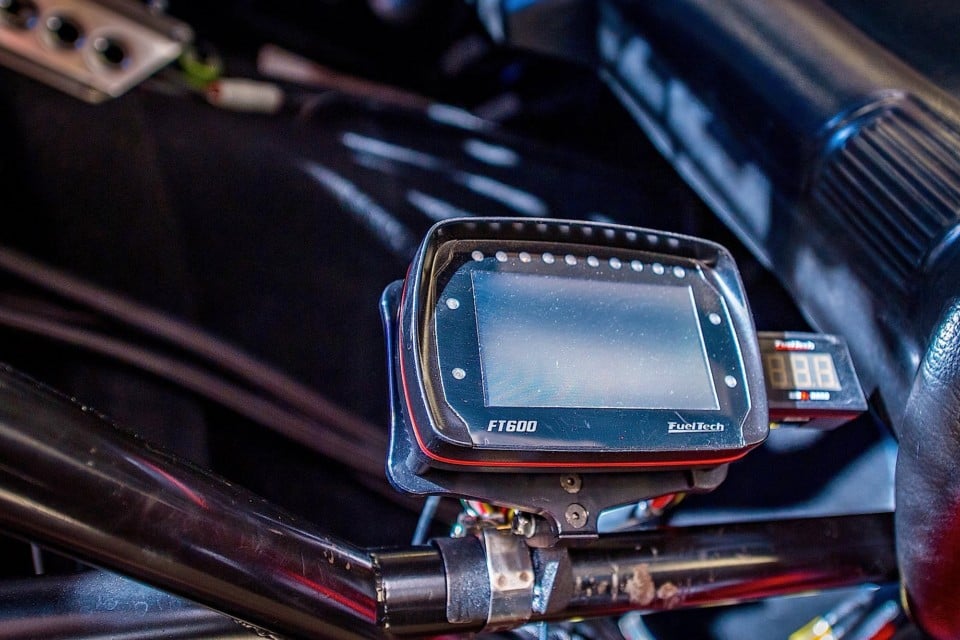
The FuelTech FT600 system includes an ECU with integrated display monitor. It allows the driver to make changes on the fly in the staging lanes.
After the conversion the initial dyno runs were extremely promising.
“The car performed flawless on the dyno with zero issues. We made over 2,000 horsepower to the tires with a conservative tune, sums up Kolivas. “This was a substantial increase over previous pulls on gasoline. With M1 setups there is obviously a little more maintenance. Oil changes are more frequent, and we check bearing wear after 15 to 20 runs. That’s compared to an entire season on gas. We feel with a larger single turbocharger and a little more weight reduction, this car can run 4-teens easily, if not 4.0s.”

